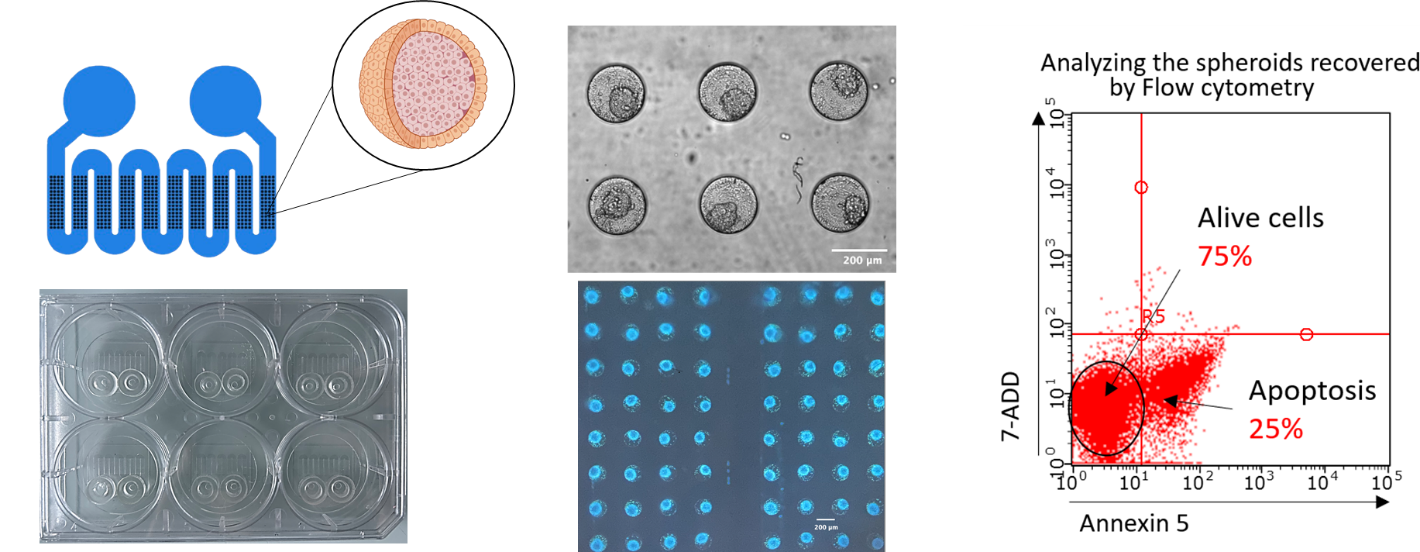
Centre de Neurophysique, Physiologie et Pathologie - CNRS UMR 8119
Université Paris Descartes
45 Rue des Saints Pères
75270 Paris Cedex 06
France
Fax : +33 (0) 1 42 86 20 80
Hugo Salmon
Myelination and Nervous system pathologies
Myelination and Nervous system pathologies and Physics advanced instrument (NABI)
Education
Engineer from Ecole Centrale de Lille, agrégé in Mathematics PhD in physics from Université Paris Saclay.
Research interests
- Thermoplastic microfluidics for analytical and organ on chip applications
- Modeling myelination, demyelination and remyelination processes in microphysiological sytems
- Extracellular vesicles interaction with myelin (transport, phenotyping and potency tests)
- Analytical techniques for physicochemical characterization of nanoparticles
Teaching
Mechanics, thermodynamics, microphysiological systems, mathematical modeling, design and fabrication, statistics, project management, improv.
Staff of the international Master’s program in Biomedical engineering
Contact
Idhal: hugosalmon
ORCID: 0000-0002-5486-1370 Profil Google scholar
Myelin on chip and the study of EV in the context of myelin
Myelin is a complex system at multiple levels: bioelectrical, biomechanical and biochemical. There are currently no therapeutic to cure demyelinating diseases. The lack of simple model complicates the screening of drug therapeutics (Moreau et al 2025, review). Our group develop compartmentalized on-chip model (Moreau. et al 2025, research article) to facilitate the screening of therapeutics and study the role of extracellular vesicles in the remyelination / demyelination processes.

Asymmetrical field flow fraction for nanobiotherapeutics: development of tailored method and miniaturization of the device
Nanomedicines and nanobiotherapeutics offer better targeting and more efficient drug delivery, enhancing therapeutic outcomes while minimizing side effects. Yet, they also complexify the formulation and interaction with biological systems, as function of their size distribution, shape and surface properties. Asymmetrical flow field flow fractionation and related techniques allow a fine characterization of theses parameters and to better understand the fate of these nanoparticles. We develop methods on our platform for different biotherapeutics. We also develop a miniaturized version of it for enhanced performances.

Massive spheroid formation for nanomedicine drug screening on a chip
The emergence of new immuno-oncotherapies has extended the therapeutic possibilities of many cancers. However, this means interacting with the tumour at a higher level of complexity. Conventional 2D in vitro models cannot satisfactorily model the tumour and its interaction with its environment. Our team is developing frugal methods for the formation and massive screening of tumours to study the potential of nanobiotherapies.

Thermoplastic microfluidics prototyping and cell biology high content screening platform
Our platform is divided in two sections:
- a prototyping platform allowing to design and fabricate polydimethilsiloxane (PDMS) and soft thermoplastic elastomer (sTPE) chips. The platform is oriented toward out-of-clean room frugal production. We recommend contacting Université Paris Cité clean room facility for more complex work
- a microscopy room for videomicroscopy of cell biology and a macroscope assisted with a pressure controller. All our instrument are fully automated, adapted for high content screening and epifluorescence microscopy with usual wavelengths.

Follow me on bluesky: https://bsky.app/profile/hugsalmon.bsky.social
Journal articles
2025
- ref_biblio
- Solène Moreau, Raul Flores-Berdines, Tatiana El Jalkh, Anne Simon, Guillaume Taret, et al.. Reversible and reusable compartmentalized thermoplastic chip for coculture of dorsal root ganglion neurons. Lab on a Chip, 2025, Online ahead of print. ⟨10.1039/D5LC00666J⟩. ⟨hal-05360835⟩
- Accès au texte intégral et bibtex
-


2024
- ref_biblio
- Solène Moreau, Raul Flores-Berdines, Tatiana El Jalkh, Anne Simon, Guillaume Taret, et al.. Reversible and reusable compartmentalized microfluidic chip for coculture of dorsal root ganglion neurons. Bioarxiv, 2024, ⟨10.1101/2024.12.10.627139⟩. ⟨hal-04987043⟩
- Accès au bibtex
-

2022
- ref_biblio
- Max Piffoux, Amanda Silva, Florence Gazeau, Hugo Salmon. Potential of on‐chip analysis and engineering techniques for extracellular vesicle bioproduction for therapeutics. Re View, 2022, 3 (1), pp.20200175. ⟨10.1002/VIW.20200175⟩. ⟨hal-03868884⟩
- Accès au bibtex
-

2021
- ref_biblio
- Hugo Salmon, M. Reza Rasouli, Nicholas Distasio, Maryam Tabrizian. Facile engineering and interfacing of styrenic block copolymers devices for low‐cost, multipurpose microfluidic applications. Engineering Reports, 2021, 3 (7), pp.479. ⟨10.1002/eng2.12361⟩. ⟨hal-04987048⟩
- Accès au bibtex
-

2020
- ref_biblio
- Nicholas Distasio, Hugo Salmon, France Dierick, Talin Ebrahimian, Maryam Tabrizian, et al.. VCAM‐1‐Targeted Gene Delivery Nanoparticles Localize to Inflamed Endothelial Cells and Atherosclerotic Plaques. Advanced Therapeutics, 2020, 4 (2), ⟨10.1002/adtp.202000196⟩. ⟨hal-04987052⟩
- Accès au bibtex
-

2019
- ref_biblio
- Hugo Salmon, Rabah Gahoual, Pascal Houzé, Tayssir Ibrahim, Michel Bessodes, et al.. Europium labeled lactosylated albumin as a model workflow for the development of biotherapeutics. Nanomedicine: Nanotechnology, Biology and Medicine, 2019, 18, pp.21-30. ⟨10.1016/j.nano.2019.02.011⟩. ⟨hal-02123126⟩
- Accès au texte intégral et bibtex
-


- ref_biblio
- Hugo Salmon, Christophe Roblin, Laurent Couraud, Gilgueng Hwang. Microrobot-in-glass for dynamic motion analysis and wider in vitro applications. Micro and Nano Letters, 2019, ⟨10.1049/mnl.2019.0006⟩. ⟨hal-02087207⟩
- Accès au bibtex
-

- ref_biblio
- Hugo Salmon, Laurent Couraud, Gilgueng Hwang. On-chip mobile microrobotic transducer for high-temporal resolution sensing using dynamics analysis. Sensors and Actuators A: Physical , 2019, 288, pp.27-38. ⟨10.1016/j.sna.2018.12.043⟩. ⟨hal-02087217⟩
- Accès au texte intégral et bibtex
-


2018
- ref_biblio
- Julie Lachaux, Hugo Salmon, Fanny Loisel, Nassim Arouche, Ignacio Ochoa, et al.. Soft Thermoplastic Elastomer for Easy and Rapid Spin‐Coating Fabrication of Microfluidic Devices with High Hydrophilization and Bonding Performances. Advanced Materials Technologies, 2018, 4 (2), ⟨10.1002/admt.201800308⟩. ⟨hal-04526639⟩
- Accès au bibtex
-

2014
- ref_biblio
- Gilgueng Hwang, Ioan Alexandru Ivan, Joël Agnus, Hugo Salmon, Sébastien Alvo, et al.. Mobile microrobotic manipulator in microfluidics. Sensors and Actuators A: Physical , 2014, 215, pp.56-64. ⟨10.1016/j.sna.2013.09.030⟩. ⟨hal-02087263⟩
- Accès au bibtex
-

Conference papers
2013
- ref_biblio
- Gilgueng Hwang, Hugo Salmon, Loan Alexandra Ivan, Joël Agnus, Nicolas Chaillet, et al.. Large range versatile wireless microrobotic manipulators in microfluidic devices. 2013 IEEE 26th International Conference on Micro Electro Mechanical Systems (MEMS), Jan 2013, Taipei, France. pp.1179-1182, ⟨10.1109/MEMSYS.2013.6474462⟩. ⟨hal-02087246⟩
- Accès au bibtex
-

- ref_biblio
- Hugo Salmon, Laurent Couraud, Gilgueng Hwang. Using breakdown phenomenon as mobile magnetic field sensor in microfluidics. 2013 IEEE/RSJ International Conference on Intelligent Robots and Systems (IROS 2013), Nov 2013, Tokyo, France. pp.2041-2046, ⟨10.1109/IROS.2013.6696629⟩. ⟨hal-02087218⟩
- Accès au bibtex
-

- ref_biblio
- Hugo Salmon, Laurent Couraud, Gilgueng Hwang. Swimming property characterizations of Magnetic Polarizable microrobots. 2013 IEEE International Conference on Robotics and Automation (ICRA), May 2013, Karlsruhe, Germany. pp.5520-5526, ⟨10.1109/ICRA.2013.6631369⟩. ⟨hal-02087219⟩
- Accès au bibtex
-

Theses
2014
- ref_biblio
- Hugo Salmon. Mobile Magnetic Microrobots Control and Study in Microfluidic Environment : New Tools for Biomedical Applications. Other [cond-mat.other]. Université Paris Sud - Paris XI, 2014. English. ⟨NNT : 2014PA112266⟩. ⟨tel-04574954⟩
- Accès au texte intégral et bibtex
-


